
Click the above Computer Enthusiasts to follow us
Last night, with the release of the Honor 30S, Huawei HiSilicon’s new generation mid-range 5G SoC – Kirin 820 finally made its official debut. Considering that during the mid-range 4G SoC era, the Kirin 810 was able to maintain performance superiority over its competitors, can the Kirin 820, crossing the 5G threshold, still retain the combat power of its predecessor?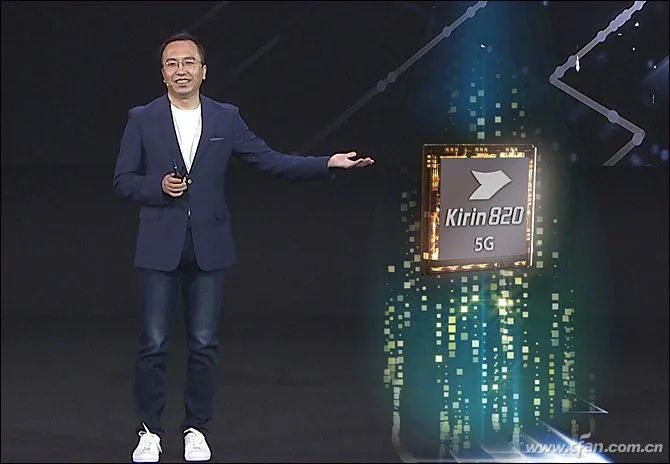 The Glorious Achievements of Kirin 810CFan previously analyzed the Kirin 810 in the article titled “The Strongest Mid-Range SoC? A Deep Dive into the Kirin 810 Mobile Platform“. Thanks to its advanced 7nm process, high big core frequency, and the Mali-G52MP6 GPU (which is enhanced compared to the standard Mali-G52 that only supports up to MP4), its overall performance can comprehensively surpass the Snapdragon 730G and MediaTek Helio G90T, making it the strongest contender among last year’s mid-range 4G SoCs.
The Glorious Achievements of Kirin 810CFan previously analyzed the Kirin 810 in the article titled “The Strongest Mid-Range SoC? A Deep Dive into the Kirin 810 Mobile Platform“. Thanks to its advanced 7nm process, high big core frequency, and the Mali-G52MP6 GPU (which is enhanced compared to the standard Mali-G52 that only supports up to MP4), its overall performance can comprehensively surpass the Snapdragon 730G and MediaTek Helio G90T, making it the strongest contender among last year’s mid-range 4G SoCs.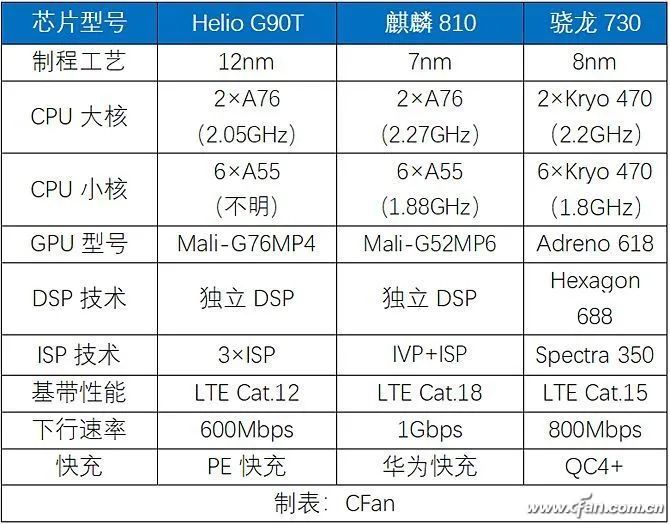
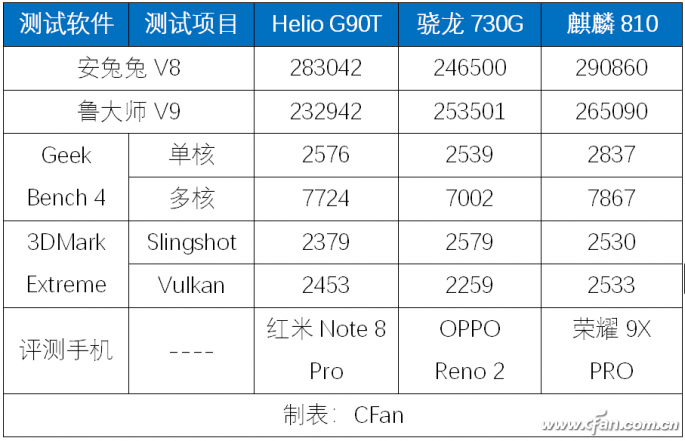 Kirin 820 Basic ParametersEntering the 5G era, new generation mid-range 5G SoCs represented by Samsung Exynos 980, Qualcomm Snapdragon 765G, and MediaTek Dimensity 1000L have been launched one after another, while MediaTek Dimensity 800 and UNISOC Tiger T7520 have also entered the “PPT stage”. The Kirin 820 has managed to catch the “last train”.
Kirin 820 Basic ParametersEntering the 5G era, new generation mid-range 5G SoCs represented by Samsung Exynos 980, Qualcomm Snapdragon 765G, and MediaTek Dimensity 1000L have been launched one after another, while MediaTek Dimensity 800 and UNISOC Tiger T7520 have also entered the “PPT stage”. The Kirin 820 has managed to catch the “last train”.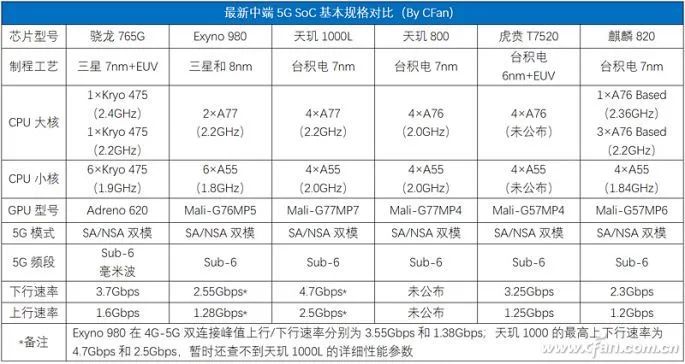 In terms of process technology, the Kirin 820 uses TSMC’s 7nm process, but note that it is not the latest 7nm EUV. In terms of technology, the Kirin 820 lags behind the Snapdragon 765G and Tiger T7520 among its peers. Fortunately, the significance of “EUV” for 7nm is mainly to shorten the lithography time, which helps reduce production cycles and costs, with minimal impact on performance. Therefore, the 7nm Kirin 820 is still worth looking forward to, considering that the Snapdragon 865 also uses this process.
In terms of process technology, the Kirin 820 uses TSMC’s 7nm process, but note that it is not the latest 7nm EUV. In terms of technology, the Kirin 820 lags behind the Snapdragon 765G and Tiger T7520 among its peers. Fortunately, the significance of “EUV” for 7nm is mainly to shorten the lithography time, which helps reduce production cycles and costs, with minimal impact on performance. Therefore, the 7nm Kirin 820 is still worth looking forward to, considering that the Snapdragon 865 also uses this process.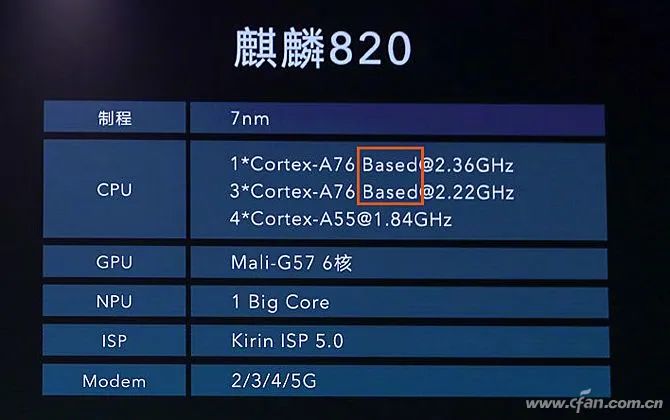 In terms of CPU, the Kirin 820 adopts a “three-cluster” design, consisting of 1 Cortex-A76 Based big core (2.36GHz) + 3 Cortex-A76 Based medium cores (2.22GHz) + 4 Cortex-A55 small cores (1.84GHz). Note the “Based” suffix for the big and medium cores, which indicates that the big and medium cores of the Kirin 820 are modified versions based on the native ARM Cortex-A76 architecture, similar to Qualcomm’s Kryo cores. In fact, during the Kirin 990 era, its big and medium cores were also modified based on Cortex-A76.
In terms of CPU, the Kirin 820 adopts a “three-cluster” design, consisting of 1 Cortex-A76 Based big core (2.36GHz) + 3 Cortex-A76 Based medium cores (2.22GHz) + 4 Cortex-A55 small cores (1.84GHz). Note the “Based” suffix for the big and medium cores, which indicates that the big and medium cores of the Kirin 820 are modified versions based on the native ARM Cortex-A76 architecture, similar to Qualcomm’s Kryo cores. In fact, during the Kirin 990 era, its big and medium cores were also modified based on Cortex-A76.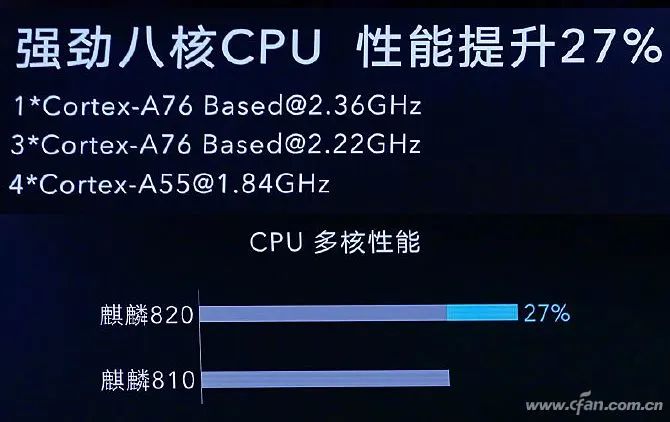 In terms of GPU, there were earlier rumors that the Kirin 820 would integrate ARM’s latest Mali-G77, but it actually integrates the Mali-G57, which may disappoint many users. In fact, the Mali-G57 is a GPU IP that ARM only released in late October 2019. Although it belongs to the Mali-G5 series, it adopts the same microarchitecture as the latest Mali-G77. Compared to the previous generation G52, the G57 has 1.3 times the performance, with a 30% improvement in energy efficiency, a 30% increase in performance density, and a 60% enhancement in machine learning capabilities. This time, the Kirin 820 also prepares 6 computing cores for the integrated GPU, and combined with Huawei’s unique GPU Turbo and Kirin Gaming+ 2.0 technology, the actual performance of the Mali-G57MP6 is still worth looking forward to.
In terms of GPU, there were earlier rumors that the Kirin 820 would integrate ARM’s latest Mali-G77, but it actually integrates the Mali-G57, which may disappoint many users. In fact, the Mali-G57 is a GPU IP that ARM only released in late October 2019. Although it belongs to the Mali-G5 series, it adopts the same microarchitecture as the latest Mali-G77. Compared to the previous generation G52, the G57 has 1.3 times the performance, with a 30% improvement in energy efficiency, a 30% increase in performance density, and a 60% enhancement in machine learning capabilities. This time, the Kirin 820 also prepares 6 computing cores for the integrated GPU, and combined with Huawei’s unique GPU Turbo and Kirin Gaming+ 2.0 technology, the actual performance of the Mali-G57MP6 is still worth looking forward to.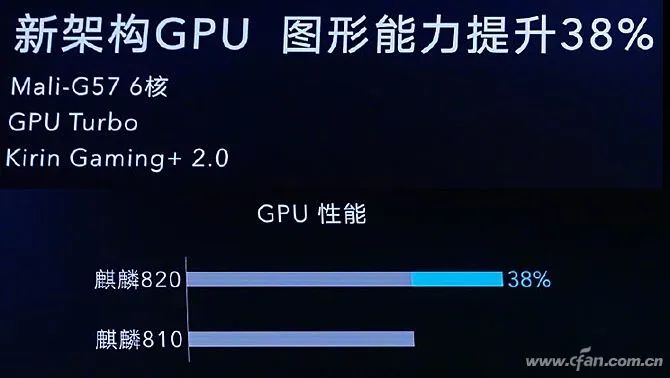 In other aspects, the Kirin 820 integrates a self-developed Da Vinci architecture NPU unit (single large core), with AI performance improved by 73% compared to the previous generation Kirin 810. In the AI Benchmark list from ETH Zurich, the Honor 30S equipped with the Kirin 820 scored an impressive 60843, demonstrating what it means to “dominate the rankings” compared to its predecessor equipped with the Kirin 990.
In other aspects, the Kirin 820 integrates a self-developed Da Vinci architecture NPU unit (single large core), with AI performance improved by 73% compared to the previous generation Kirin 810. In the AI Benchmark list from ETH Zurich, the Honor 30S equipped with the Kirin 820 scored an impressive 60843, demonstrating what it means to “dominate the rankings” compared to its predecessor equipped with the Kirin 990.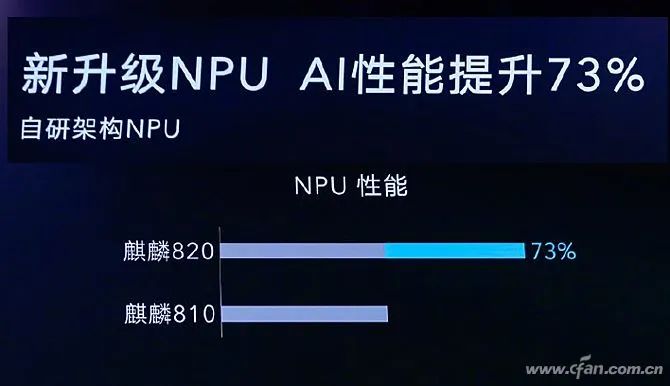
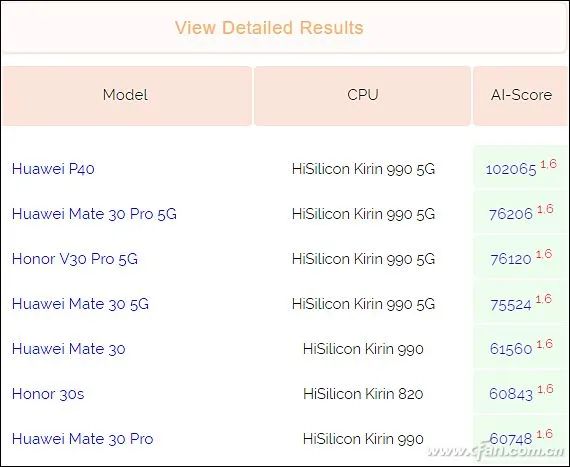 The Kirin 820 has upgraded to the Kirin ISP 5.0 image processing unit, supporting BM3D DSLR-level image noise reduction and dual-domain video noise reduction, with a 15% increase in ISP throughput, a 15% improvement in energy efficiency, a 30% enhancement in photo noise reduction capabilities, and a 20% improvement in video noise reduction capabilities.
The Kirin 820 has upgraded to the Kirin ISP 5.0 image processing unit, supporting BM3D DSLR-level image noise reduction and dual-domain video noise reduction, with a 15% increase in ISP throughput, a 15% improvement in energy efficiency, a 30% enhancement in photo noise reduction capabilities, and a 20% improvement in video noise reduction capabilities.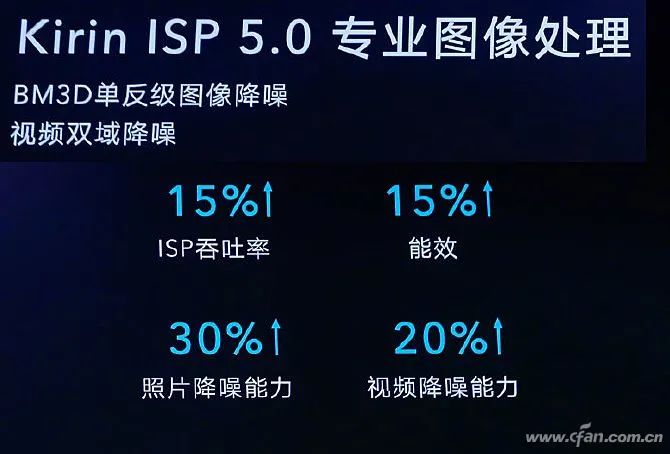 The Kirin 820 also integrates the same 5G modem (Balong 5000) as the Kirin 990 5G, supporting SA/NSA dual-mode and five core frequency bands (N1/N3/N41/N78/N79) from the three major operators, with theoretical downlink/uplink rates of 2.3Gbps and 1.2Gbps, respectively.
The Kirin 820 also integrates the same 5G modem (Balong 5000) as the Kirin 990 5G, supporting SA/NSA dual-mode and five core frequency bands (N1/N3/N41/N78/N79) from the three major operators, with theoretical downlink/uplink rates of 2.3Gbps and 1.2Gbps, respectively.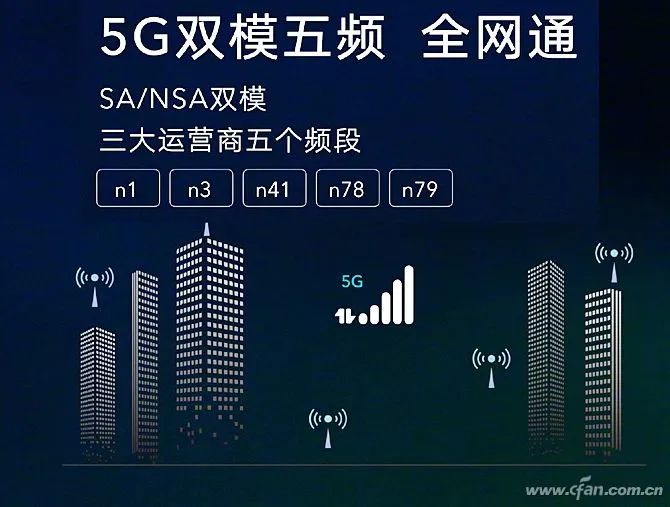 Kirin 820 Performance TestingAs the saying goes, “You have to take it out for a walk to see if it’s a mule or a horse”. To understand how powerful the Kirin 820 really is, we need to look at its theoretical performance benchmark comparisons with major competitors.
Kirin 820 Performance TestingAs the saying goes, “You have to take it out for a walk to see if it’s a mule or a horse”. To understand how powerful the Kirin 820 really is, we need to look at its theoretical performance benchmark comparisons with major competitors.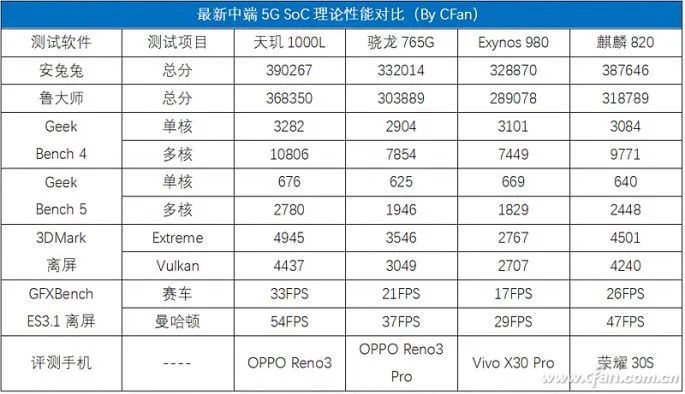 In this segment, the Kirin 820 also performs impressively, easily outperforming its two main competitors, the Snapdragon 765G and Exynos 980. Its CPU performance is very close to that of the Dimensity 1000L, but its GPU performance is slightly inferior to that of the Dimensity 1000L. Additionally, considering that the Kirin 820’s single-core score is slightly behind the Exynos 980, we can draw the following conclusion:The modified Cortex-A76 architecture of the Kirin 820 is still not as good as the native ARM Cortex-A77. However, the Kirin 820 has 4 modified Cortex-A76 Based cores, which compensate for the microarchitecture shortcomings with absolute quantity, resulting in impressive multi-core performance. On the other hand, the performance of the new generation mid-range Mali-G57 is already comparable to that of the previous generation high-end Mali-G76, with the 3D performance of Mali-G57MP6 (Kirin 820) significantly surpassing that of Mali-G76MP5 (Exynos 980).Overall, the Kirin 820 perfectly inherits the legacy of the previous generation Kirin 810, possessing substantial combat potential in the new generation of mid-range 5G SoCs, at least leaving the Snapdragon 765G and Exynos 980 with no chance to counter. As for the Dimensity 1000L, considering its niche market, even if its performance is strong, it is unlikely to significantly impact the status of the Kirin 820.
In this segment, the Kirin 820 also performs impressively, easily outperforming its two main competitors, the Snapdragon 765G and Exynos 980. Its CPU performance is very close to that of the Dimensity 1000L, but its GPU performance is slightly inferior to that of the Dimensity 1000L. Additionally, considering that the Kirin 820’s single-core score is slightly behind the Exynos 980, we can draw the following conclusion:The modified Cortex-A76 architecture of the Kirin 820 is still not as good as the native ARM Cortex-A77. However, the Kirin 820 has 4 modified Cortex-A76 Based cores, which compensate for the microarchitecture shortcomings with absolute quantity, resulting in impressive multi-core performance. On the other hand, the performance of the new generation mid-range Mali-G57 is already comparable to that of the previous generation high-end Mali-G76, with the 3D performance of Mali-G57MP6 (Kirin 820) significantly surpassing that of Mali-G76MP5 (Exynos 980).Overall, the Kirin 820 perfectly inherits the legacy of the previous generation Kirin 810, possessing substantial combat potential in the new generation of mid-range 5G SoCs, at least leaving the Snapdragon 765G and Exynos 980 with no chance to counter. As for the Dimensity 1000L, considering its niche market, even if its performance is strong, it is unlikely to significantly impact the status of the Kirin 820.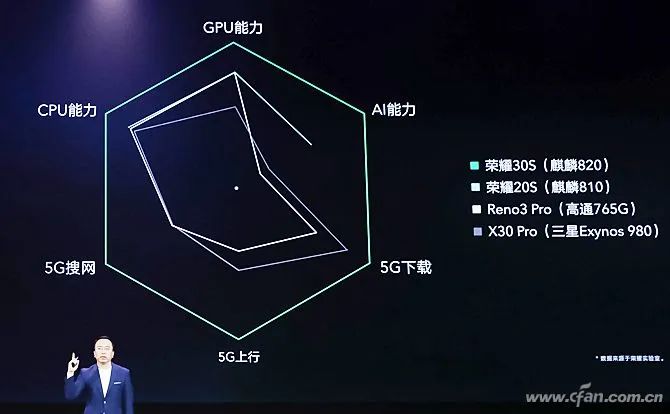 As the first phone to feature the Kirin 820, the Honor 30S has a starting price of only 2399 yuan, making it difficult for the similarly positioned Redmi K30 5G. In the second half of the year, the Honor family will also release the lower-positioned Honor 10X. If it can price below 1700 yuan while featuring the Kirin 820, it is expected to become the catalyst for a collective price drop in mid-range 5G phones.
As the first phone to feature the Kirin 820, the Honor 30S has a starting price of only 2399 yuan, making it difficult for the similarly positioned Redmi K30 5G. In the second half of the year, the Honor family will also release the lower-positioned Honor 10X. If it can price below 1700 yuan while featuring the Kirin 820, it is expected to become the catalyst for a collective price drop in mid-range 5G phones.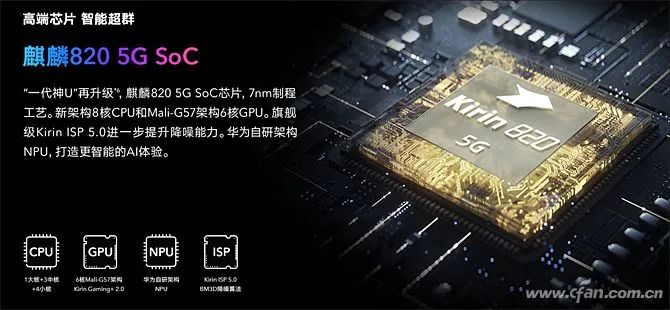

Click “Read the original” for more exciting content